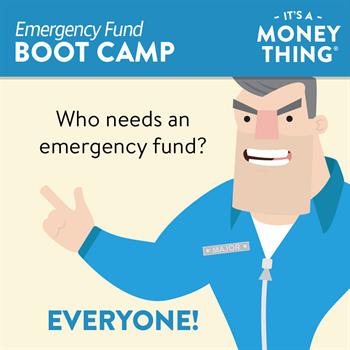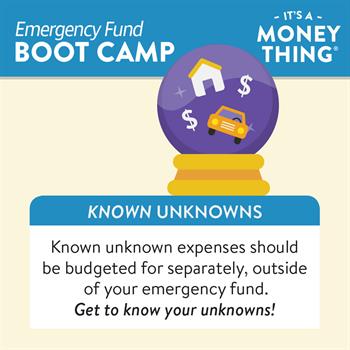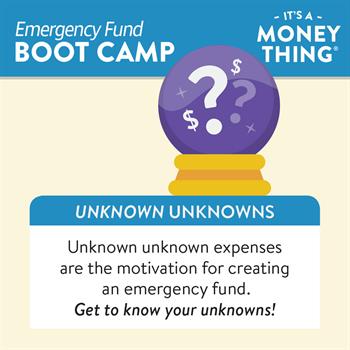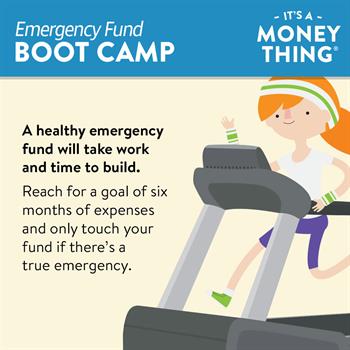It's a Money Thing®
Emergency Fund Boot Camp, Because Life Happens
An emergency fund is an essential part of your personal finances. Its importance is stressed in almost every personal finance book and budgeting blog, and yet 26% of Americans currently have no emergency fund in place. Of those who do have an emergency fund, up to two-thirds do not have the often-recommended six months’ worth of expenses saved up.
If an emergency fund is so important, why doesn’t it seem that way? Why do so many put off contributing to an emergency fund?
The term itself could be a source of confusion. The word “emergency” brings to mind images of car crashes, natural disasters and terrible accidents—and although these are valid examples of emergency expenses that affect people all across the country every day, they’re extreme enough that it’s difficult to imagine ourselves in those situations. It can be difficult to set aside a large chunk of change for emergencies when you “just don’t feel that your car is going to break down today”. Our wants (or discretionary spending) often feel more immediate than our need to cover hypothetical and unpredictable emergency expenses.
But, whatever name you give it, absolutely everyone needs an emergency fund in place because no one is exempt from life’s surprises and obstacles—and while we can’t completely prevent emergency situations, we can at least limit their potential damage. An emergency fund allows you to respond immediately to financial emergencies, which allows you to handle the situation without having to deal with additional stresses like struggling to make ends meet or spiraling into a cycle of debt.

Let’s look at what types of expense should—and shouldn’t—be dealt with by an emergency fund.

Expense Type #1: Known unknowns
“Known unknowns” are situations that we can partially anticipate—so this is the type of expense that should not be dealt with by an emergency fund. These situations are on our radar (known), even if we don’t know exactly when they will happen (unknown). For example, if you own a vehicle, you know that at some point it will need repairs, just like you know that your home will eventually need a new furnace or that your pet will eventually need a visit to the vet.
A good budgeting exercise is to make a list of all the known unknown expenses you can think of. Then compare the list to your budget and see if there are any categories you’re not currently saving for. Odds are that there are probably a few areas your current budget doesn’t cover, so you’ll want to adjust it to include these additional categories.
Expense Type #2: Unknown unknowns
“Unknown unknowns”, which are the types of expenses that emergency funds are truly designed for, are situations that take us completely by surprise. We don’t know when they will happen, how much they’ll cost or even what they will be until they’ve happened. For example, a family member could suddenly fall ill and you need time away from work in order to care for them. Hopefully, you’ll never experience an unknown unknown, but if you do, the knowledge that you have an emergency fund to cover additional expenses will undoubtedly help to ease a stressful situation.
If an expense is unexpected (or it results from an unexpected circumstance) and it has the ability to derail your regular cash flow, then it’s an emergency expense. By that definition, a delayed insurance reimbursement is as much of an emergency expense as a meteorite landing on your car. The important part is being prepared for those expenses, no matter how mundane or how extreme they turn out to be.


How much should be in your emergency fund?
Emergency funds vary widely from person to person. The regular recommendation is six months’ worth of expenses, but some prefer having nine months’ or a year’s worth tucked away. It’s a significant amount, as it should be—it’s what you would be living off if you didn’t have an income for an extended period of time. Whatever amount you choose, it’s a hefty savings goal and it will take time to meet it, but it will make all the difference in tough times. When setting your emergency-fund savings goal, consider the following:
- Avoid wishful thinking: According to a 2014 Workopolis survey, it takes four months on average to find a new job. When planning your emergency budget, you might like to think that if you lost your job, you could turn it all around in two weeks—but that could be setting yourself up for a very stressful situation. It’s not fun to think about a worst-case scenario, but when it comes to emergency-fund planning, that kind of thinking can help you come up with a more realistic savings goal.
- Imagine your lifestyle: If you had to quit your job in order to handle an emergency situation, what would your lifestyle look like? Would you be willing to rough it until you found a new job? Or would you need things to stay pretty much the same to stop your stress levels from skyrocketing? Consider your desired lifestyle carefully when planning your emergency fund. If maintaining your current lifestyle in times of emergency is a priority to you, you may want to save nine months’ worth of income, rather than nine months’ worth of expenses. But if rolling with the punches and going back to a diet of ramen noodles while you figure things out is more your style, then a smaller emergency fund would likely be able to meet your needs.
Ultimately, your emergency fund is about your peace of mind. Design it to fit your specific needs.

